Tired of looking at that dull, cracked concrete?
You’re not alone.
Concrete resurfacing has become the go-to solution for homeowners wanting to revamp their spaces without the hefty price tag of a complete tear-out and replacement.
The following ten decorative options will transform your boring concrete into stunning surfaces that look like they belong in a home design magazine.
Each technique offers its own unique aesthetic while providing durability and value.
Stamped Concrete Overlays: Luxury Looks Without the Luxury Price
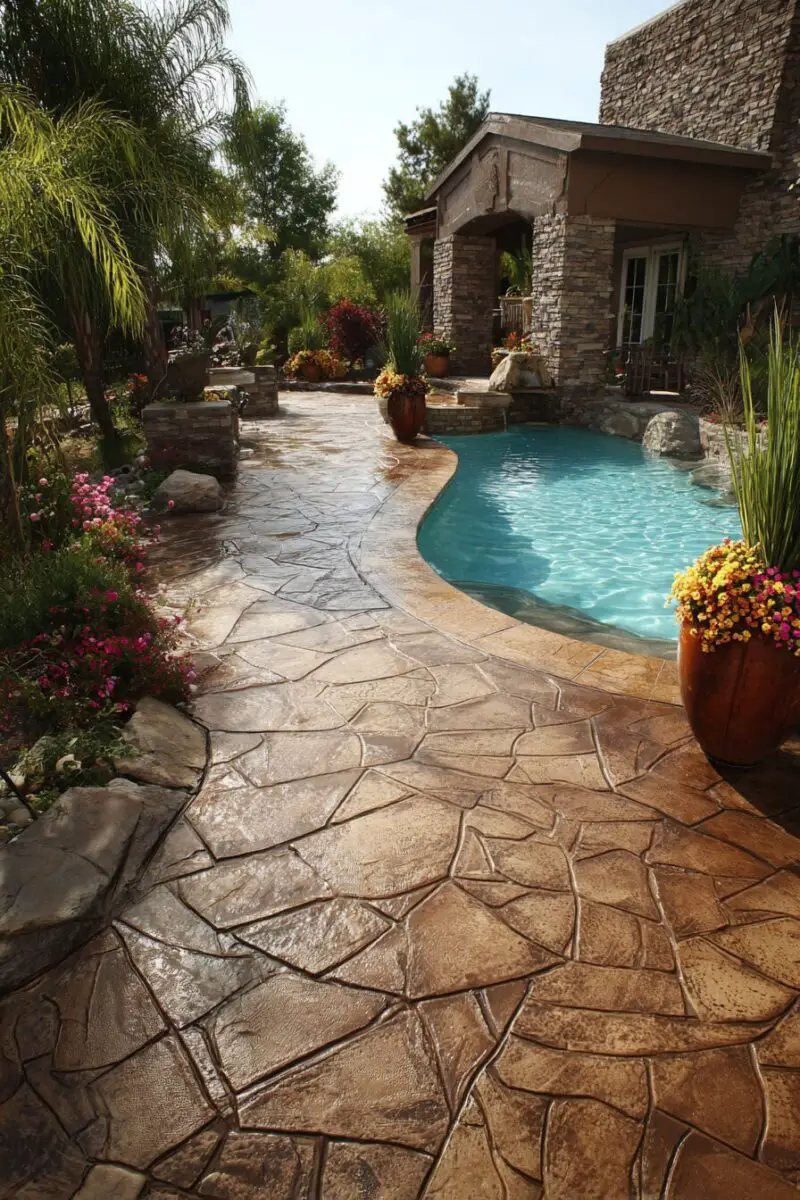
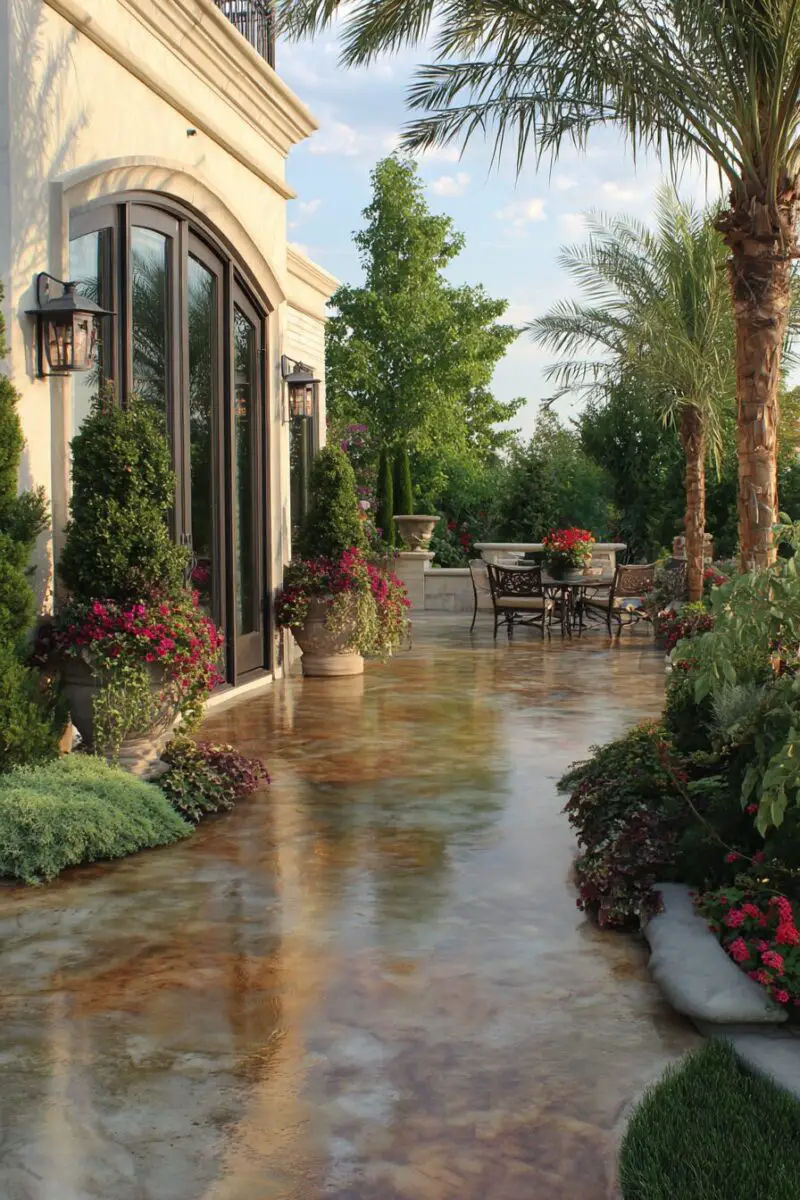
Stamped concrete overlays are thin layers of cement-based material applied over existing concrete surfaces.
These overlays can be stamped with patterns that mimic expensive materials like natural stone, brick, or even wood.
The process involves applying a cement-based overlay material to your existing concrete at a thickness of about 1/4 to 3/8 inch.
While the material is still wet, large rubber stamps are pressed into the surface to create realistic texture patterns.
You can choose from dozens of stamp patterns including slate, flagstone, cobblestone, brick, and even wood grain.
Color can be added either to the overlay mix itself or applied later as a stain or dye to create natural-looking variations.
The result is a completely transformed surface that looks nothing like the original concrete.
One of the biggest advantages is getting the look of expensive materials like natural stone without the high cost and installation challenges.
For your patio, this could mean the difference between a basic concrete slab and what appears to be an elegant slate terrace.
Stamped overlays typically cost 30-50% less than installing actual stone or pavers.
The durability is impressive too, often lasting 10-15 years with proper sealing and maintenance.
You’ll need to reseal the surface every 2-3 years to maintain its appearance and protection.
Stamped overlays work beautifully for pool decks, patios, driveways, walkways, and even indoor floors.
The texture provided by stamping also creates slip-resistant surfaces, making them safer around pools and in wet areas.
Professional installation is recommended for best results, as timing is crucial for proper stamping.
You can enhance the look with antiquing colors that highlight the texture and create depth and dimension.
Border patterns can be added to frame the space and create visual interest around the edges.
For a truly custom look, you might combine different stamp patterns—perhaps a cobblestone border around a slate-patterned patio.
The versatility of stamped overlays means you can match the design to your home’s architectural style, whether it’s rustic, modern, or traditional.
Think about your color choices carefully—earth tones tend to look more natural and hide dirt better than stark whites or very dark colors.
TRENDING NOW
13 Stunning Exterior Ideas For Brown Brick HomesAcid Staining: Rich, Marbled Effects That Never Go Out of Style
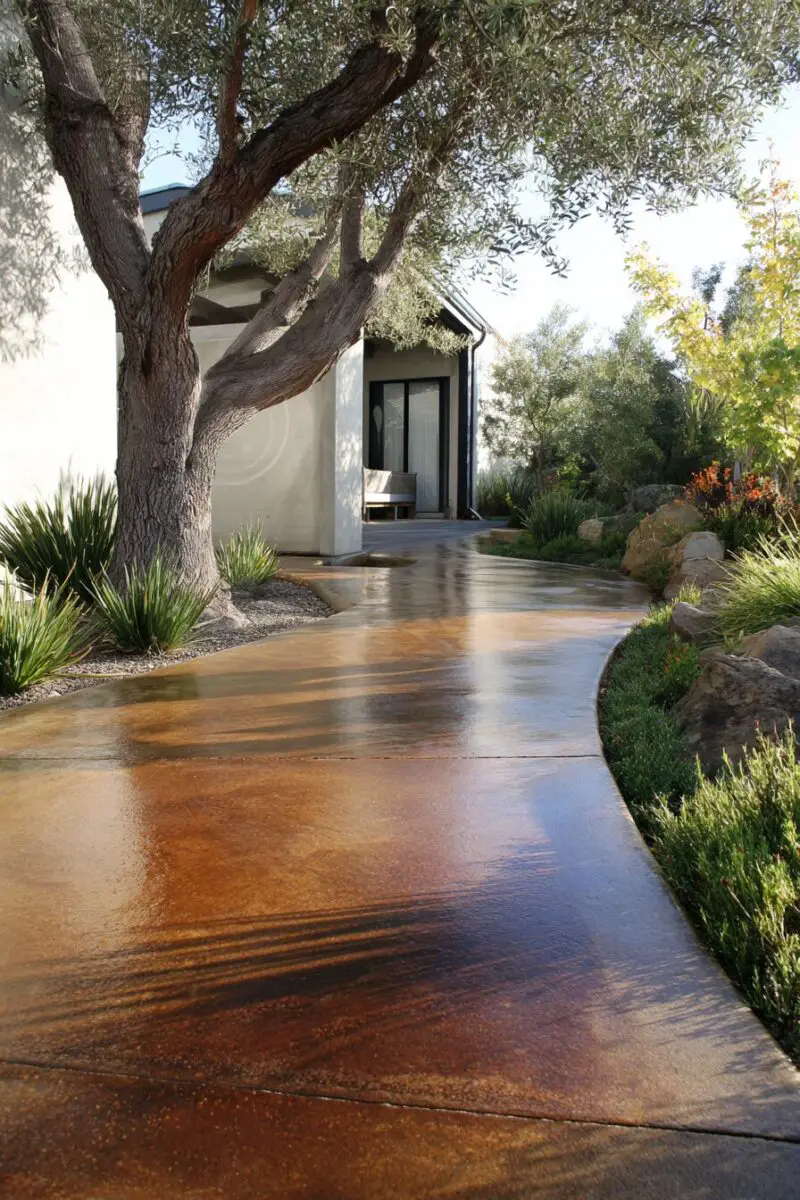
Acid staining creates rich, translucent color effects that penetrate the concrete rather than just coating the surface.
This chemical reaction between the acid and the concrete’s minerals produces unique, one-of-a-kind marbled effects.
The process involves applying an acid-based solution containing metallic salts that react with the lime in concrete.
Once applied, the stain penetrates the concrete and creates permanent color that won’t fade, chip, or peel like paint would.
You can choose from a range of earth-toned colors including amber, blue-green, brown, and terra cotta.
The final appearance depends on the concrete’s composition, age, and texture, making each installation truly unique.
No two acid-stained floors will ever look exactly alike, even when the same colors are used.
This technique works best on existing concrete that’s in relatively good condition but can hide minor imperfections.
For indoor applications, acid-stained concrete floors offer an elegant alternative to traditional flooring materials.
The rich, variegated appearance resembles natural stone or leather, adding warmth and character to any space.
Outdoor applications benefit from acid staining’s UV-resistance and ability to withstand harsh weather conditions.
After staining, a sealer must be applied to protect the surface and enhance the colors.
You can choose between high-gloss, satin, or matte sealers depending on your preferred look.
Maintenance is relatively simple—regular sweeping and occasional mopping with a neutral cleaner is typically sufficient.
The cost of acid staining is generally less than installing new flooring materials like hardwood or natural stone.
Professional application is recommended due to the caustic nature of the chemicals and the skill required for beautiful results.
You can create more complex designs by using stencils or tape to block off areas for different colors.
The subtle color variations created by acid staining can help hide dirt and imperfections better than solid-colored surfaces.
This technique works especially well in rustic or Tuscan-style homes but can be adapted to complement modern décor as well.
Consider using darker stains in high-traffic areas where dirt and wear are more likely to show.
Design Your Dream Room in Minutes!
🏡 Start Creating FREE →Decorative Scoring and Engraving: Custom Patterns That Make a Statement
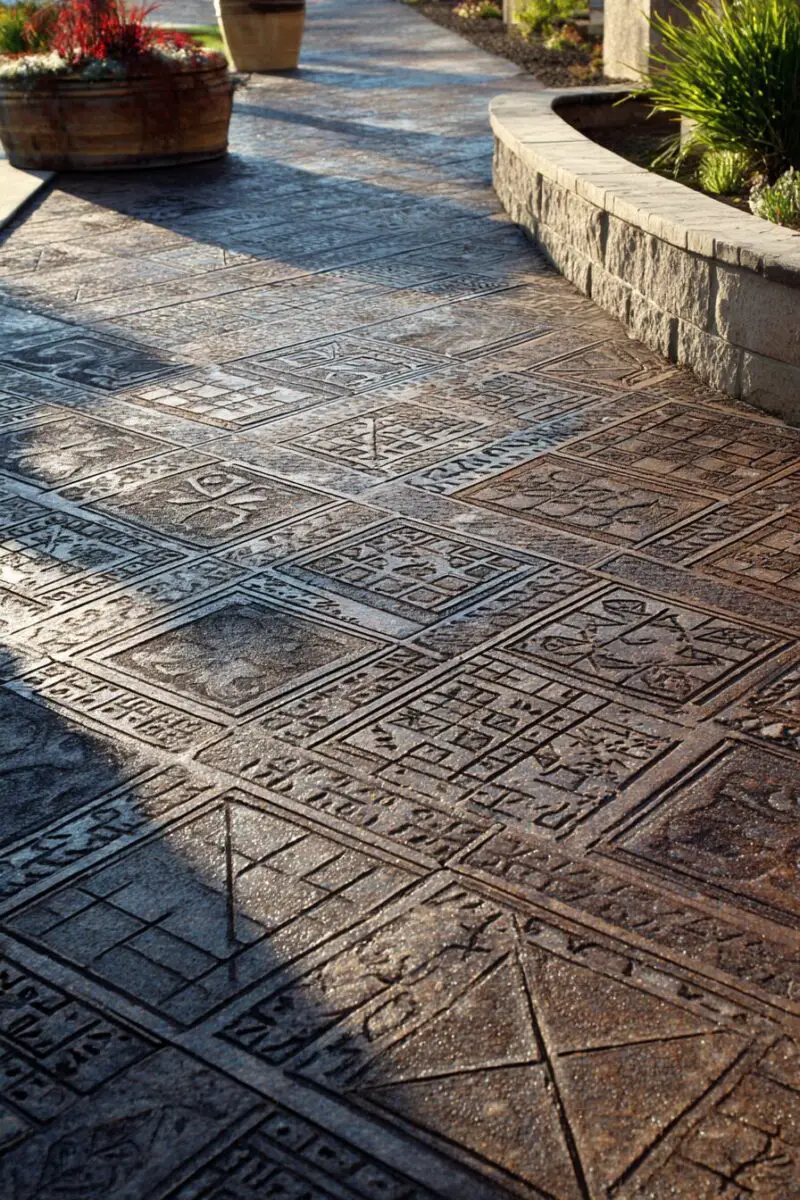
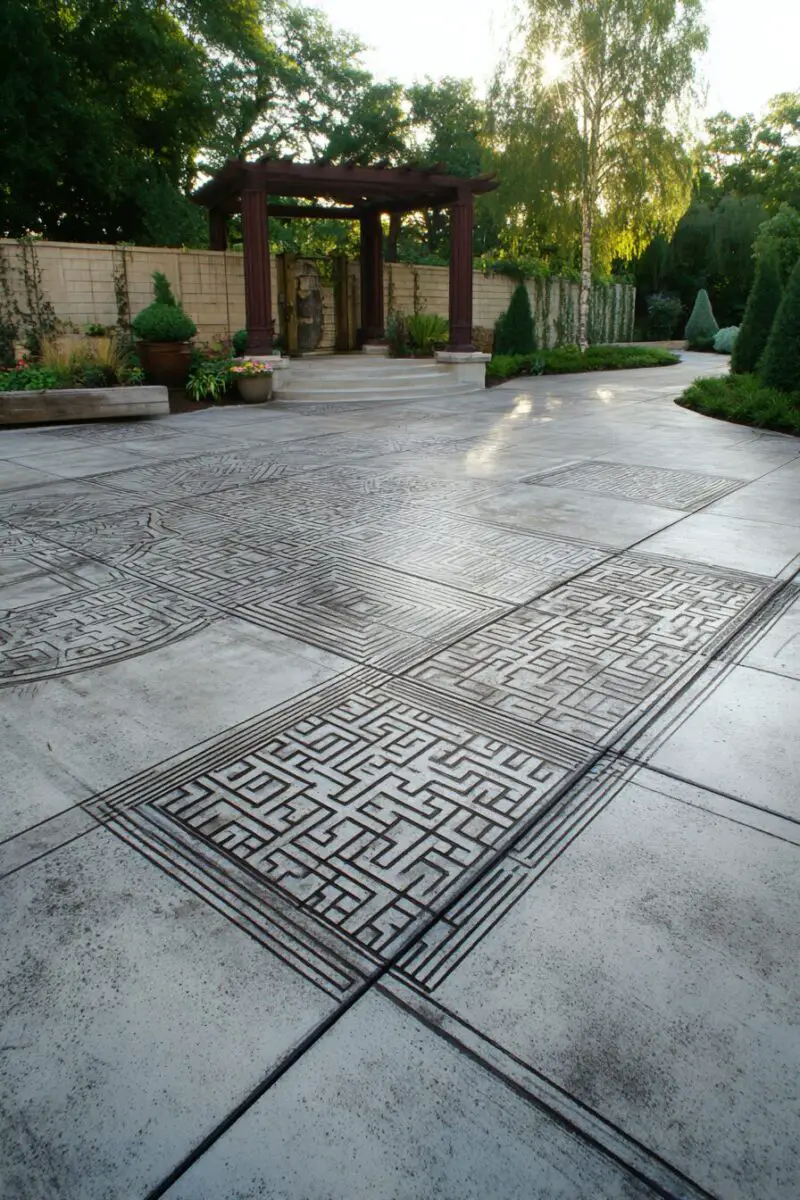
Decorative scoring and engraving involves cutting lines or designs into concrete surfaces to create patterns or mimic the look of tiles.
This technique transforms plain concrete into a canvas for geometric patterns, borders, or even custom artwork.
Special concrete saws and engraving tools are used to cut shallow lines into the surface of existing concrete.
The depth of these cuts typically ranges from 1/16 to 1/4 inch, creating defined lines without compromising structural integrity.
You can choose from simple grid patterns that mimic large format tiles to complex geometric designs or medallions.
Once the concrete is scored, the lines can be left as is or filled with contrasting colored grout for added definition.
Staining or coloring can be applied before or after scoring to enhance the overall design and create multi-colored effects.
The precision of modern tools allows for intricate designs including circles, curves, and even custom logos or graphics.
For homeowners with good concrete that just looks plain, this is one of the most cost-effective transformation options.
The ability to create the appearance of individual tiles without actual grout lines means fewer maintenance headaches.
You won’t have to worry about crumbling grout or cleaning between tiles as you would with traditional tile installations.
This technique works beautifully for creating the look of large-format stone tiles on patios and pool decks.
Indoor applications often include entryways, kitchens, and living areas where a custom floor design makes a statement.
Decorative scoring can be combined with staining to create multi-colored designs that mimic inlaid stone or intricate tile work.
The cost varies based on design complexity but is generally less expensive than removing and replacing concrete.
Professional installation is recommended for precise, clean cuts and complex design execution.
Simple geometric patterns like squares or diamonds are more budget-friendly than intricate custom designs.
You can use decorative scoring to visually separate spaces in open floor plans without actual walls or barriers.
The technique is especially valuable for updating older homes where concrete is structurally sound but visually dated.
Consider using scoring to create borders around the edges of spaces or to frame focal points like fire pits or water features.
Microtoppings and Skim Coats: Smooth, Modern Surfaces for Contemporary Spaces
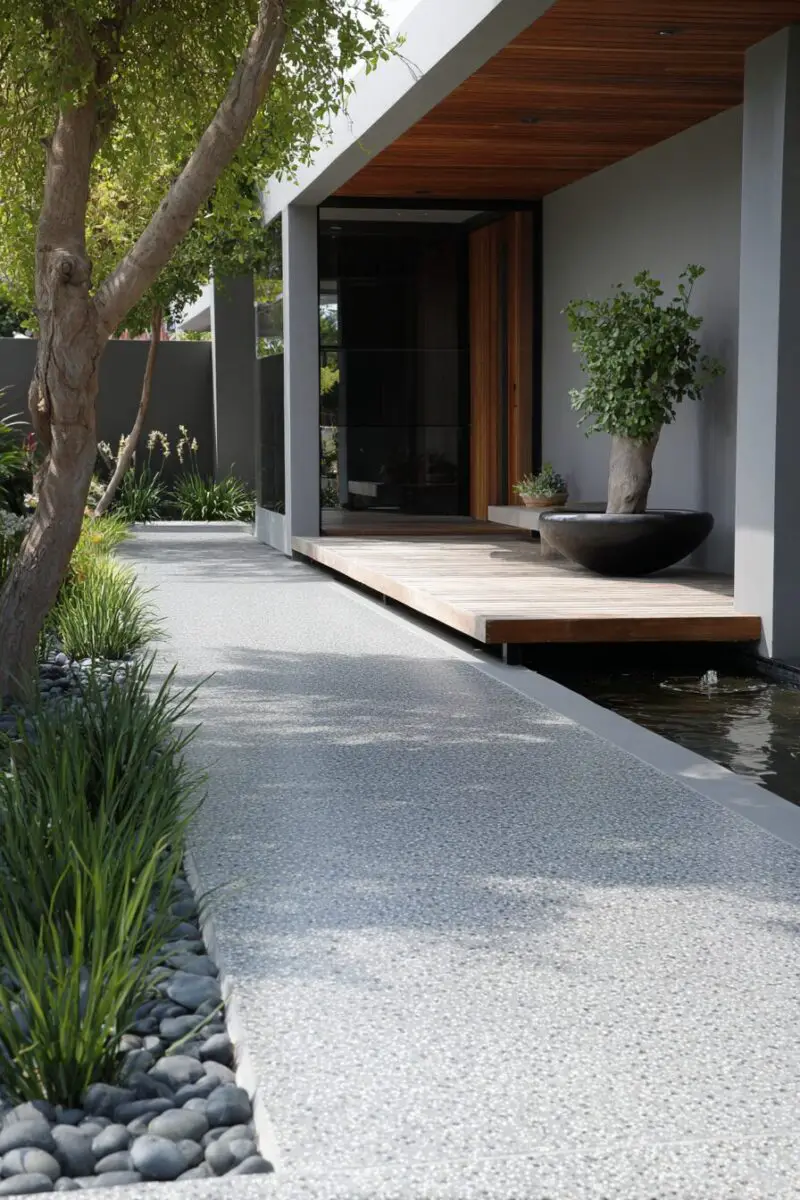
Microtoppings and skim coats are ultra-thin layers of polymer-modified cement applied to existing concrete surfaces.
These applications can be as thin as 1/16 inch, making them perfect for concrete that’s in good structural condition but has surface imperfections.
The result is a smooth, blank canvas that can be colored, stained, or textured in countless ways.
Modern microtopping formulations contain advanced polymers that create exceptionally strong bonds with the underlying concrete.
You can achieve looks ranging from sleek and minimalist to artistic and colorful depending on the finishing techniques.
The ultra-smooth finish is particularly popular in contemporary and industrial-style homes and businesses.
Application typically involves multiple thin layers, each troweled on and allowed to dry before the next is applied.
Colors can be integrated into the microtopping material or applied afterward using dyes, stains, or tinted sealers.
For a truly unique look, artists can create hand-troweled effects with subtle variations in texture and color.
The smooth surface makes this option ideal for indoor spaces where a seamless, modern look is desired.
In commercial spaces, microtoppings can be used to create branded environments with custom colors and designs.
The thinness of the application means you don’t lose headroom in spaces with low ceilings, unlike thicker overlays.
Maintenance is straightforward—regular cleaning and occasional resealing will keep the surface looking fresh for years.
You can achieve looks ranging from natural concrete to polished marble depending on the coloring and finishing techniques.
For homes with multiple floor levels, microtoppings create a cohesive look without the thick transitions of traditional flooring.
The quick installation process means less disruption to your home or business operations.
Most microtopping projects can be completed in just a few days, including drying time between coats.
These surfaces are ideal for radiant heating systems, as the thin material allows heat to transfer efficiently.
The versatility of microtoppings makes them suitable for both horizontal and vertical surfaces, including countertops and wall features.
Epoxy Flooring with Decorative Flakes: Durable Brilliance for High-Traffic Areas
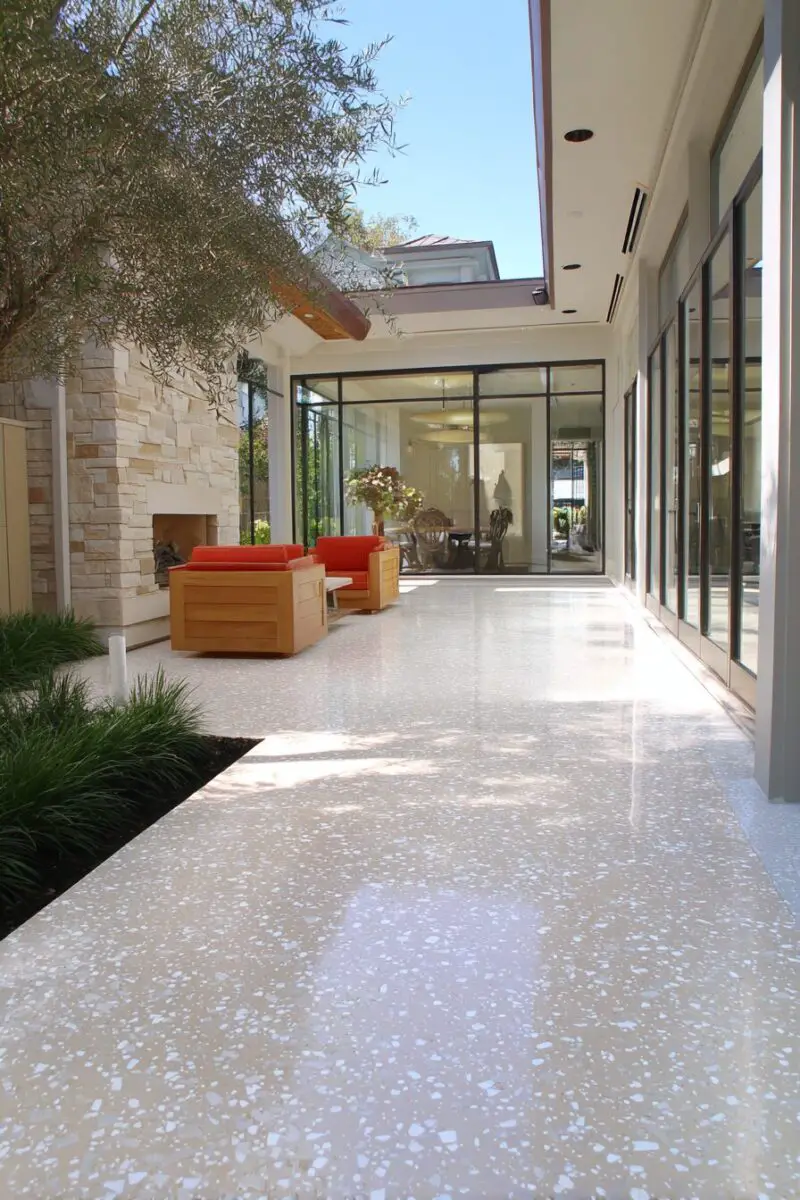
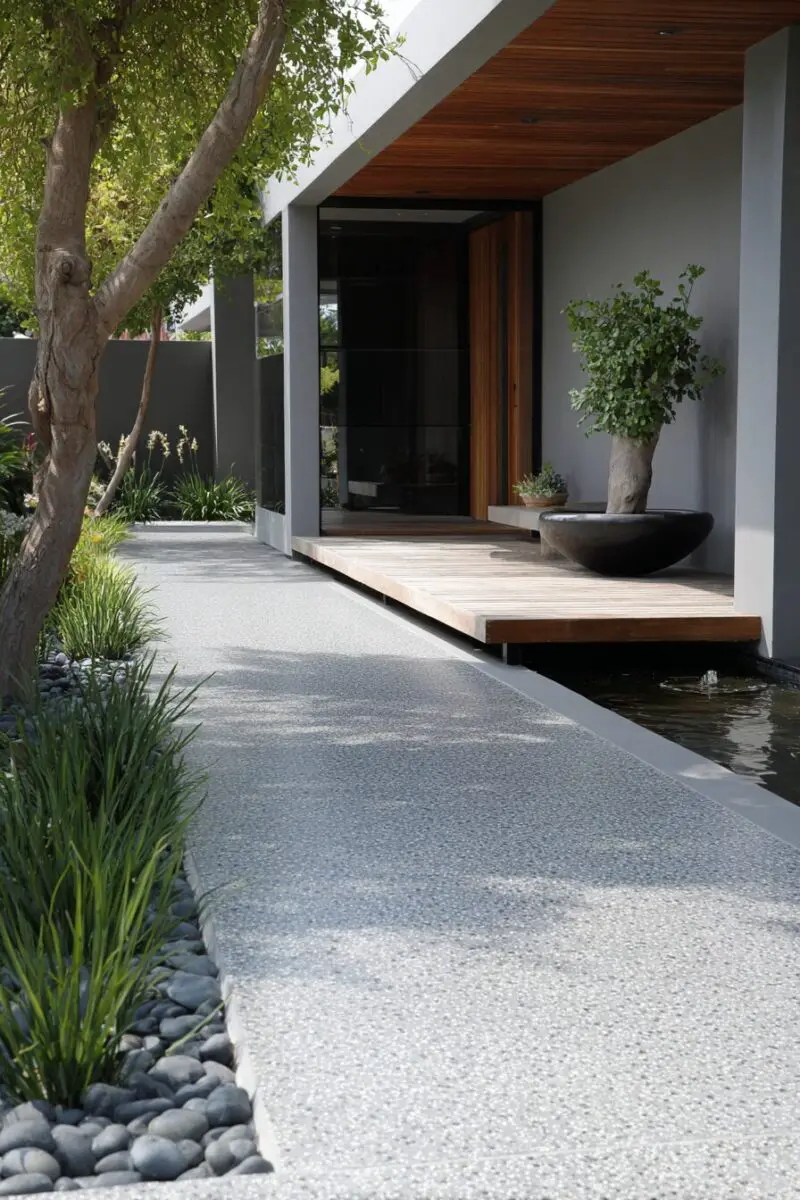
Epoxy flooring systems combine durability with unlimited design potential for concrete surfaces.
When decorative flakes or chips are broadcast into wet epoxy, the result is a multi-dimensional, terrazzo-like appearance.
The process starts with thorough surface preparation to ensure proper adhesion of the epoxy materials.
A primer coat is applied first, followed by a base coat of colored epoxy resin.
While the base coat is still wet, vinyl color flakes are broadcast onto the surface—either partially or to full rejection.
These flakes come in countless color combinations, allowing for completely customized color schemes.
The size of the flakes can range from micro-sized for a more subtle appearance to large chips for bold visual impact.
After the base coat cures, loose flakes are removed and a clear topcoat seals everything in place.
The resulting surface is exceptionally durable, often lasting 15-20 years in residential applications.
Epoxy floors are chemical-resistant, making them ideal for garage floors that might be exposed to automotive fluids.
The seamless, non-porous nature of epoxy makes it extremely easy to clean—just sweep and mop as needed.
You can choose metallic epoxy for a flowing, three-dimensional appearance that resembles marble or molten metal.
For businesses, logo designs can be incorporated using custom-colored flakes or embedded designs.
The high-gloss finish of most epoxy systems reflects light, making spaces appear brighter and larger.
In basements prone to moisture, epoxy provides a waterproof barrier that protects against potential dampness.
The comfort underfoot can be improved by adding a final coat with texture for slip resistance.
Modern epoxy formulations have minimal odor and VOCs, making them more user-friendly than earlier versions.
You can achieve looks ranging from subtle speckled patterns to bold, multi-colored designs resembling confetti.
For outdoor applications, UV-resistant epoxy formulations prevent yellowing and color fading from sun exposure.
Polished Concrete Finishes: Sophisticated Shine with Industrial Edge

Polished concrete transforms ordinary concrete into glossy, mirror-like surfaces through a multi-step grinding and polishing process.
This technique doesn’t add a coating but instead grinds the actual concrete surface to a high polish.
The process involves using progressively finer diamond grinding tools to smooth and polish the concrete surface.
You can choose different levels of shine, from matte to high-gloss, depending on how many polishing steps are performed.
During the polishing process, a chemical hardener is applied that reacts with the concrete to create a denser, stronger surface.
The result is a floor that’s not only beautiful but also extremely durable and resistant to abrasion.
Colors can be added during the process using dyes or stains that penetrate the concrete.
For a truly unique look, aggregates in the concrete can be exposed at different levels during grinding.
This technique is particularly popular in modern and industrial-style spaces but works in traditional homes too.
The reflective quality of polished concrete helps maximize natural light, potentially reducing lighting costs.
Maintenance is minimal—regular dust mopping and occasional damp mopping is usually all that’s needed.
Unlike coatings that can wear off or peel, polished concrete’s finish is integral to the floor and won’t wear away.
The process actually makes the concrete stronger and more resistant to staining and moisture penetration.
You can incorporate decorative saw cuts or engraving before polishing to add patterns or designs.
For commercial spaces, this flooring option offers exceptional durability even under heavy foot traffic.
The cost varies based on the existing concrete condition and the level of polish desired.
Concrete with significant damage may require more extensive preparation before polishing can begin.
The process is environmentally friendly as it uses the existing concrete rather than adding new materials.
You might consider adding glass, metal fragments, or colored aggregates to the surface before polishing for unique effects.
For homes with pets, polished concrete offers a surface that’s resistant to scratches and easy to clean.
Concrete Stenciling: Artistic Patterns with Endless Possibilities
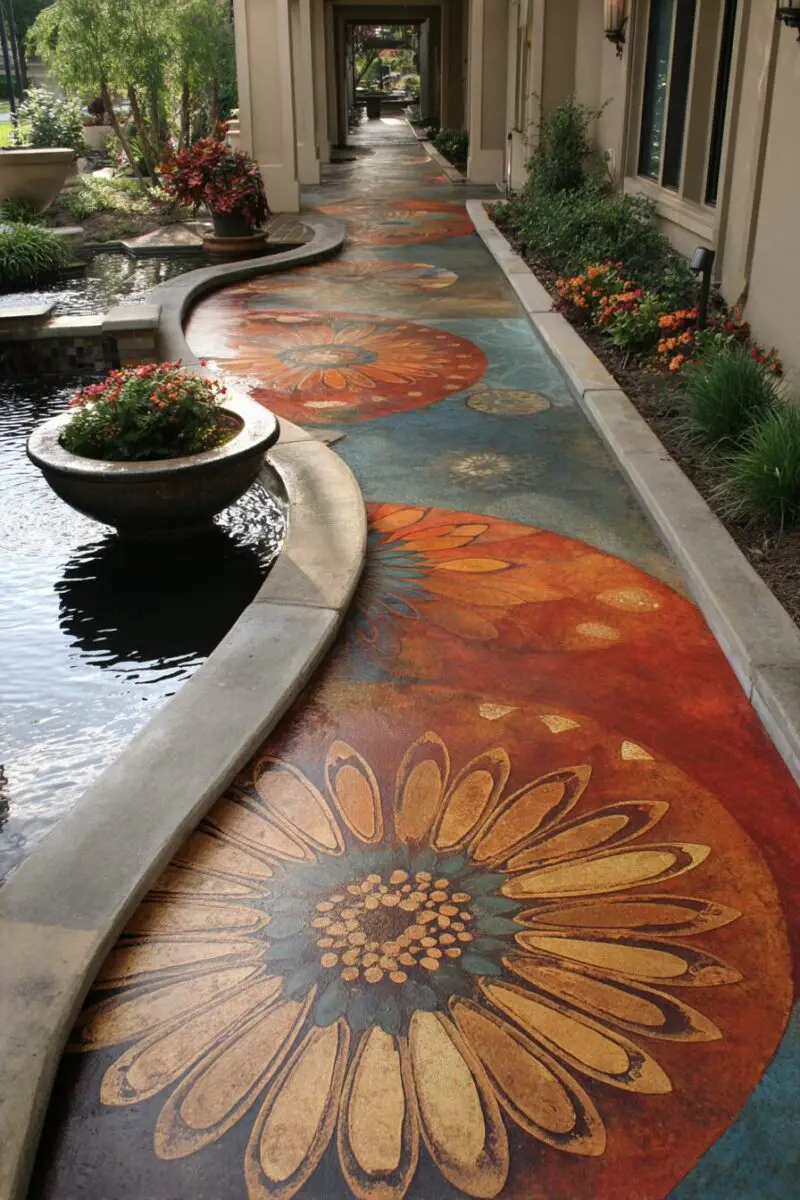
Concrete stenciling allows for intricate patterns and designs to be created on concrete surfaces using adhesive stencils.
This technique combines the durability of concrete with the design flexibility typically associated with other flooring types.
The process begins with preparing the concrete surface and applying a base coat of colored overlay material.
Adhesive stencils are then placed on the surface in the desired pattern—options include tile patterns, geometric designs, or custom artwork.
A contrasting color of overlay material is applied over the stencils, creating the pattern when the stencils are removed.
You can choose from hundreds of pre-made stencil designs or have custom stencils created for truly unique installations.
The technique works for both new concrete installations and resurfacing of existing concrete.
For a more subtle look, colors that are only slightly different from the base can create elegant tone-on-tone patterns.
Bold color contrasts create more dramatic visual impact and can become a focal point in your design scheme.
The precision of modern stencil materials allows for incredibly detailed designs that look hand-painted.
This technique is particularly effective for creating the look of expensive encaustic cement tiles at a fraction of the cost.
Outdoor applications benefit from the durability of concrete while enjoying design flexibility previously limited to indoor spaces.
Stenciled concrete is sealed after completion to protect the design and enhance the colors.
You can create borders, medallions, or full-surface patterns depending on your design preferences.
The cost varies based on the complexity of the stencil design and the size of the area to be covered.
Professional installation is recommended for large or complex patterns to ensure proper alignment.
For commercial spaces, stenciling can incorporate branding elements or thematic designs that enhance the customer experience.
The technique works well for vertical surfaces too, allowing for decorative concrete walls that complement floor designs.
Think about scale when choosing patterns—larger patterns generally work better in bigger spaces, while smaller patterns suit intimate areas.
TRENDING NOW
Unique Fence Lighting Ideas For Your HomeExposed Aggregate Finishes: Natural Texture with Timeless Appeal

Exposed aggregate finishes reveal the natural stones within concrete for a textured, decorative surface.
This technique has been popular for decades because of its durability and natural appearance.
The process involves removing the top layer of cement paste to expose the aggregate (stones) beneath.
For resurfacing projects, a new layer of concrete containing decorative aggregates is applied over the existing concrete.
You can choose from natural river rock, crushed granite, glass, or even seashells as the exposed materials.
The color options are extensive, with aggregates available in virtually every color and size imaginable.
Traditional exposed aggregate has a rough texture, making it excellent for slip resistance around pools and on sloped driveways.
Modern techniques allow for smoother finishes where the aggregate is just barely exposed for a more refined look.
The depth of exposure can be controlled to create different textures and appearances.
Seeding is a technique where additional decorative aggregates are broadcast onto the surface for higher concentrations.
You can create patterns and designs by using different colored aggregates in defined areas.
Border treatments often incorporate smaller or contrasting aggregates for visual definition.
This finish is exceptionally durable and weather-resistant, making it ideal for outdoor applications.
The textured surface hides dirt and small imperfections better than smooth concrete finishes.
Maintenance typically involves occasional pressure washing to remove dirt and refresh the appearance.
Sealing is recommended to enhance the colors and provide protection against staining.
You might consider combining exposed aggregate with other techniques like stamping for unique hybrid finishes.
For modern homes, white cement with black or dark gray aggregates creates a sophisticated, contemporary look.
Beach-themed properties benefit from aggregates like seashells or blue glass for a coastal aesthetic.
The timeless appeal of exposed aggregate means your investment will stay in style for decades to come.
Metallic Epoxy Finishes: Liquid Art for Dramatic Floors

Metallic epoxy finishes create stunning three-dimensional effects that resemble flowing lava, marble, or abstract art.
This high-end decorative option uses metallic pigments suspended in clear epoxy resin.
The application process begins with a solid color base coat that provides background depth.
Metallic pigments are then mixed into clear epoxy and poured onto the surface.
As the epoxy self-levels, the metallic particles move and create swirling, pearlescent effects.
Installers can manipulate the wet epoxy using various tools to create intentional patterns or allow random formations.
You can choose from dozens of metallic color options including copper, silver, gold, blue, green, and red.
The three-dimensional appearance changes as you walk across the floor and view it from different angles.
No two metallic epoxy floors are exactly alike, making each installation a unique work of art.
The glossy finish reflects light dramatically, adding brightness and perceived space to any room.
These floors are particularly striking in spaces with good lighting that highlights the dimensional effects.
Indoor applications are most common, with residential uses including living rooms, basements, and bathrooms.
Commercial installations often feature metallic epoxy in showrooms, retail spaces, and restaurants where the wow factor adds value.
The seamless surface is waterproof and easy to clean, making it practical despite its high-end appearance.
You can create multi-colored effects by using different metallic pigments in different areas.
Adding clear chips or glass to the mix creates additional texture and visual interest.
The durability of epoxy means these artistic floors can last for many years with proper care.
Maintenance requires only regular sweeping and occasional damp mopping with mild cleaners.
For truly dramatic effects, black base coats with bright metallic pigments create the most striking contrast.
Custom Concrete Murals and Graphics: Personal Expression in Permanent Form

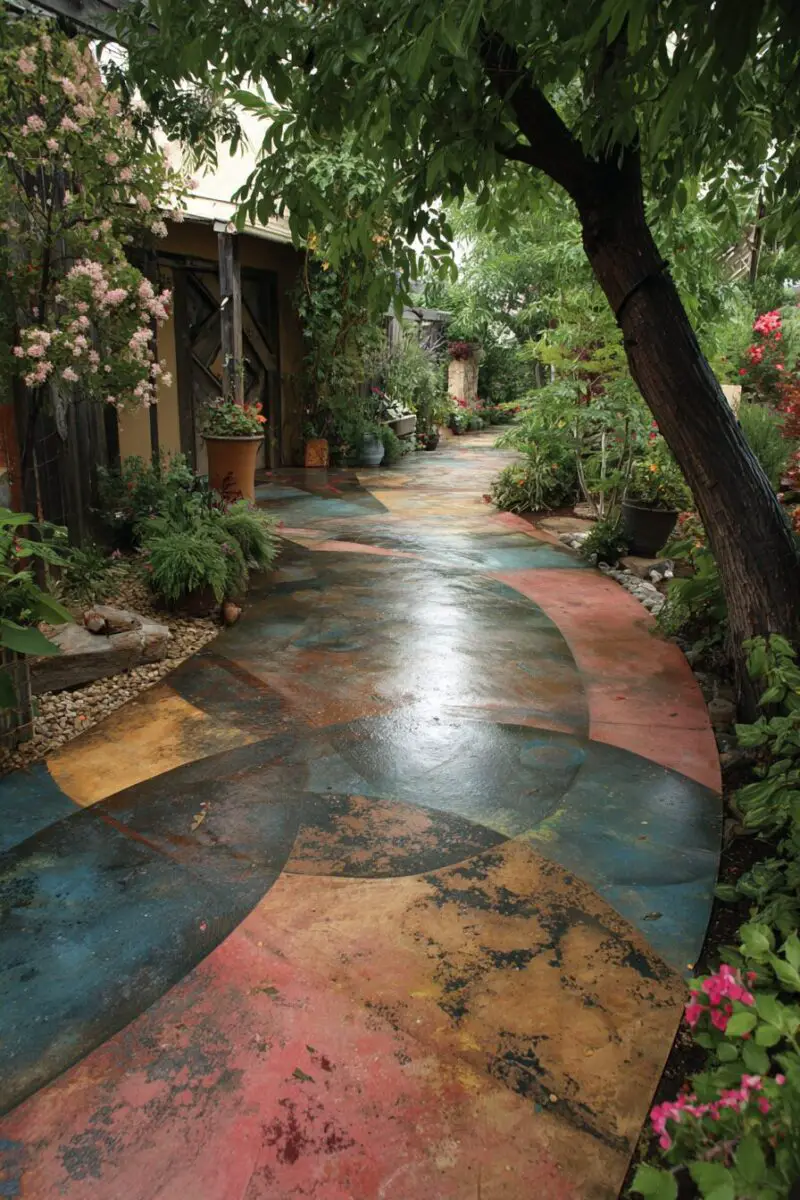
Custom concrete murals and graphics transform ordinary concrete into personalized art installations.
This technique allows for images, patterns, and designs to be permanently incorporated into concrete surfaces.
The process typically uses a combination of staining, dyeing, engraving, and specialized application techniques.
You can recreate photographs, abstract designs, company logos, or any imagery you can imagine.
The application methods vary based on the desired effect, from hand-applied stains to stencil systems.
Some techniques involve engraving the concrete and filling the cuts with different colored materials.
Advanced methods include photo-realistic transfers that can reproduce detailed images on concrete surfaces.
The permanence of these installations makes them ideal for commemorative or significant personal imagery.
Commercial applications often include brand logos and themed environments that enhance customer experience.
Residential uses range from subtle accent designs to bold full-floor or wall murals.
The cost varies significantly based on the complexity of the design and the techniques required.
Simple geometric patterns or single-image designs are more affordable than complex, multi-colored scenes.
Professional artists specializing in concrete as their medium produce the most impressive results.
You can incorporate glow-in-the-dark elements for unique nighttime effects in entertainment spaces.
The durability of properly sealed concrete art means your design will last for many years without fading.
For outdoor installations, UV-resistant colorants ensure the image remains vibrant despite sun exposure.
Consider scale carefully—larger spaces can accommodate more detailed designs that are visible from a distance.
Smaller accent pieces work well for highlighting specific areas like entryways or around fire features.
The context of the space should inform the design—nautical themes for pool areas or natural elements for garden paths.
Think about viewing angles when planning your design, especially for floor applications that will be seen from different perspectives.
These options demonstrate the remarkable versatility of concrete as a decorative medium.
Remember that proper preparation and sealing are key to long-lasting results with any of these methods.
With these innovative techniques, your tired concrete can become the most striking feature of your home.


